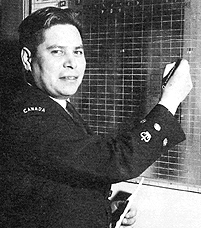“He thought it was an honour to serve his country,” said Ruby Jamieson of her husband, George Edward “Ted” Jamieson, a sailor and distinguished naval veteran of both the Second World War and the Korean War.
“He started from the very bottom and retired as a Chief Petty Officer 1st Class – a young Native man from the Six Nations Reserve.”
Born in Toronto in 1922, Jamieson was a member of the Six Nations Upper Cayuga band. He joined the Sea Cadets in his early teens and later, despite being underage, persuaded his recruiter to allow him to enrol in the Royal Canadian Naval Volunteer Reserve (RCNVR) as a bugler. Buglers were responsible for relaying calls down the hatches like “mess” for meals, “reveille” for wakeups and “lights out.”
When Canada declared war on Germany in 1939, 18-year-old Jamieson was put on active service and transferred to the gunnery branch as an Able Seaman to assist with the ship’s maintenance and safety.
He began training in Halifax before joining His Majesty’s Canadian Ship (HMCS) Drummondville, a Bangor-class minesweeper. Jamieson soon found himself confronting the bitter conditions of the North Atlantic while escorting convoys to Britain. After several stints protecting merchant vessels, Jamieson returned ashore to HMCS Cornwallis and volunteered to serve in the Pacific.
By the time he was 30, Jamieson was awarded the Canadian Forces Decoration (CD) honouring his 12 years of service. At this point Jamieson was a Chief Petty Officer 2nd Class and despite his several years in service, he extended his term with the RCN for another five years, returning to service when the Korean War broke out in 1950.
Aboard one of three RCN warships sent to support the United Nations’ mission to restore peace and counter North Korea’s invasion of South Korea, Jamieson served as the Chief Torpedo Anti-Submarine (TAS) Instructor. However, in Korea, naval duties were unusual.
Because North Korea’s small navy had been destroyed early in the war, RCN crews faced no threats from enemy destroyers or submarines. In the absence of enemy warships, the greatest dangers to sailors were mines and enemy shore batteries.
This is the exact threat Jamieson faced when HMCS Iroquois came under attack on October 2, 1952, while stationed in the Sea of Japan on the east coast. The destroyer was firing at a railway line when it came under attack from shore. Three men died, two were seriously injured and eight sustained minor injuries. Jamieson was unharmed in the attack and was back in action the next day.
He remained aboard Iroquois until January 1953, six months before the war ended, but his return to Halifax didn’t mark the end of his naval career.
He fulfilled several roles with the Navy in the wake of the war. He assumed the duties of Chief Boatswain Mate, responsible for navigation, deck maintenance, small boat operations and supervising personnel. Jamieson was also a qualified anti-submarine specialist, served as Senior Instructional Chief Petty Officer in Halifax, where he oversaw instructors and prepared course materials and examinations.
In recognition of his service, he received the Queen’s Coronation Medal and in 1955 and was promoted to Chief Petty Officer 1st Class – the Navy’s most senior non-commissioned rank.
In 1960, Jamieson retired from the RCN, taking a job as a Staff Sergeant at a Correctional Institution. Although he changed career paths, Jamieson remained on the Reserve Emergency list for five years after leaving the RCN. He went on to work as a counsellor in his home community at the Six Nations’ Drug and Alcohol Centre for over a decade.
He passed away on July 6, 1987, at the age of 65.
Jamieson’s years with the RCN are part of a proud tradition of military service by the First Nations, Inuit, and Métis peoples of Canada. From the war of 1812 to present-day operations, Indigenous members of the Canadian Armed Forces have made significant contributions to the safety and security of Canada, both at home and overseas.
Jamieson was a trailblazer – his contributions not only promoted international peace and security, but also helped pave the way for current Indigenous sailors serving in the RCN.
Source: The Maple Leaf












